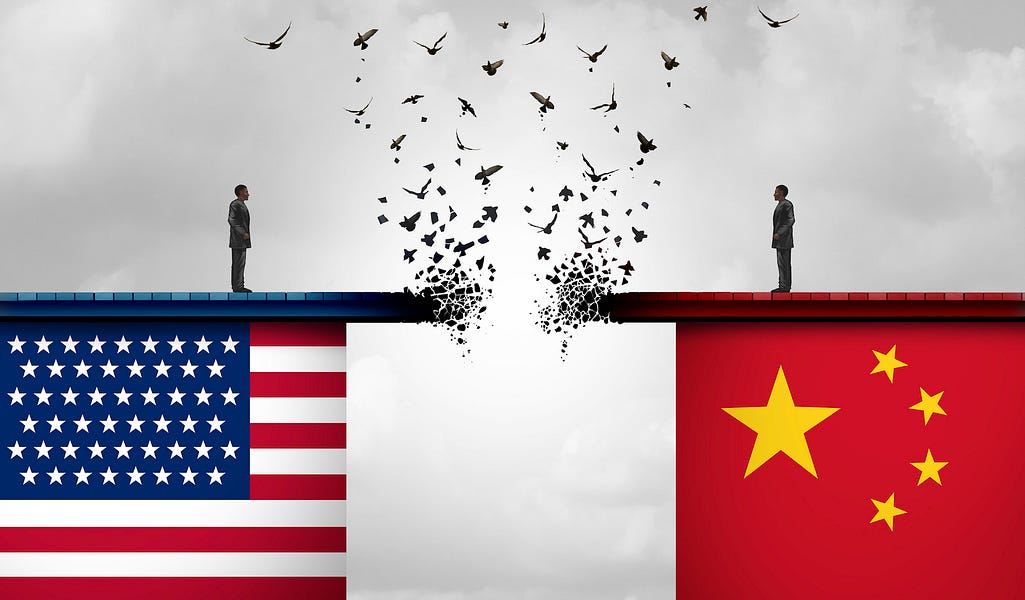- Arvind's Newsletter
- Posts
- Arvind's Newsletter-Weekend edition
Arvind's Newsletter-Weekend edition
Issue No #740
1.This weekend edition of the newsletter has a few articles on China, starting with the first on how countries including India are competing to be China’s rival as the World’s factory.Western companies are desperately looking for a backup to China as the world’s factory floor, a strategy widely termed “China plus one."India is making a concerted push to be the plus one opines the Walls Street Journal. Some excerpts from this article by Philip Wen.
“Many countries are competing to be the “plus one," with Vietnam, Mexico, Thailand and Malaysia in particular contention.
India must still overcome entrenched problems that have kept it a bit player in global supply chains. Its labor force remains mostly poor and unskilled, infrastructure is underdeveloped and the business climate, including regulations, can be burdensome. Manufacturing remains small relative to the size of India’s economy.
Nonetheless, after decades of disappointment, it is making progress. Its manufactured exports were barely a tenth of China’s in 2021, but they exceeded all other emerging markets except Mexico’s and Vietnam’s, according to World Bank data.
The biggest gains have been in electronics, where exports have tripled since 2018 to $23 billion in the year through March. India has gone from making 9% of the world’s smartphone handsets in 2016 to a projected 19% this year, according to Counterpoint Technology Market Research.
Foreign direct investment into India averaged $42 billion annually from 2020 to 2022, a doubling in under a decade, according to central bank figures.
Since China declared a “no limits" friendship with Russia on the eve of the invasion of Ukraine last year, the U.S. and its allies have stepped up efforts to reduce dependence on China. Through “friendshoring," the U.S. is “strengthening integration with our many trusted trading partners–including India," Treasury Secretary Janet Yellen said on a visit there in February.
For all this progress, it isn’t clear it’s enough to set India apart. Jules Shih, a Chennai-based director of Taiwan’s trade promotion agency, TAITRA, said India has become an easier place to do business, but in many respects still lags other countries.
It can take longer to get land and approvals to set up a factory in India and getting visas for expatriate technicians, managers and engineers is time consuming, Mr. Shih said. “We feel they don’t have a united goal integrated across agencies to make Make in India happen faster," he said.”
2.The genomes of 47 people of various ethnic backgrounds were published in a more diverse update of the Human Genome Project. In 2003, the first ever near-complete human genome was sequenced. It had taken 13 years and the project cost $2.7 billion. Now, a complete genome can be sequenced in hours for about $600. But there had never been a successor to the original project, which had only looked at one mixed-race man from New York state. The new project includes the DNA of people from around the world, and should give a clearer picture of how genetics relate to health and disease reports the New York Times.
3.The streaming wars are over, and it’s time for media to figure out what’s next, opines Alex Sherman, media reporter for CNBC.
“It’s become clear the biggest media and entertainment companies are operating in a world where significant streaming subscriber growth simply isn’t there anymore – and they’re content not to chase it hard. The current big media narrative is all about getting streaming to profitability.
Raising prices and cutting costs isn’t a great growth strategy. Streaming was a growth strategy. Maybe it will come back a bit with cheaper advertising tiers and Netflix’s impending password sharing crackdown.
That probably means the media and entertainment industry will need a new growth story soon. Will that be gaming ?”Read on.
4.One of China’s most renowned international relations scholars, Yan Xuetong warns Chinese Businesses that De-globalisation is here to stay.
Yan, who is Director of the Institute of International Relations, Tsinghua University, Beijing, addressing an audience made up mainly of Chinese entrepreneurs and investors, discusses the general decline of the world we are living in marked by an increasingly fraught US-China relationship, the bi-polarisation of the current international order and a trend towards de-globalisation.
His main message to his audience was that Chinese firms should review their long-term strategies and no longer rely so much on international cooperation and the effects of globalisation to grow their businesses. This generally regressive and adverse environment will last for another one-to-two decades or longer, he says. Long Read.
Is China’s Power about to Peak? is explored in the Leader of the Economist this week.
The rise of China has been a defining feature of the world for the past four decades. Since the country began to open up and reform its economy in 1978, its GDP has grown by a dizzying 9% a year, on average. That has allowed a staggering 800m Chinese citizens to escape from poverty. Today China accounts for almost a fifth of global output. The sheer size of its market and manufacturing base has reshaped the global economy. Xi Jinping, who has ruled China for the past decade, hopes to use his country’s increasing heft to reshape the geopolitical order, too.
There is just one catch: China’s rapid rise is slowing down. Mr Xi promises a “great rejuvenation” of his country in the coming decades, but the economy is now undergoing something more prosaic: a great maturation. Whereas a decade ago forecasters predicted that China’s GDP would zoom past America’s during the mid-21st century (at market exchange rates) and retain a commanding lead, now a much less dramatic shift is in the offing, resulting in something closer to economic parity.
This change in economic trajectory is the subject of fierce debate among China-watchers. They are thinking again about China’s clout and its rivalry with America. One view is that Chinese power will fall relative to that of its rivals, which could paradoxically make it more dangerous. In a book last year, Hal Brands and Michael Beckley, two scholars, popularised a theory they called “Peak China”. The country faces decay, they argue, and has reached “the point where it is strong enough to aggressively disrupt the existing order but is losing confidence that time is on its side”. Their study opens with an imagined war over Taiwan.
The Peak China thesis rests on the accurate observation that certain tailwinds are turning to headwinds, hindering Chinese progress. The first big gust comes from demography. China’s working-age population has been declining for about a decade. Last year its population as a whole peaked, and India has now overtaken it. The Communist Party’s attempts to convince Chinese couples to have more children are not working. As a result, the UN thinks that by mid-century China’s working-age population could decline by over a quarter. Wave goodbye to the masses of young workers who once filled “the world’s factory”.Adding workers is one way for an economy to grow. Another is to make better use of the existing population. But China’s second problem is that output per worker is unlikely to rise as fast as forecasters once hoped. More of its resources will go to caring for the elderly. After decades of building houses, roads and railways, spending on infrastructure faces diminishing returns. Mr Xi’s autocratic tendencies have made local entrepreneurs more nervous, which may reduce China’s capacity to innovate in the long run. Geopolitical tensions have made foreign firms eager to diversify supply chains away from China. America wants to hobble China’s capabilities in some “foundational” technologies. Its ban on exporting certain semiconductors and machines to Chinese firms is expected to cut into China’s GDP.
All of this is dampening long-run forecasts of China’s economic potential. Twelve years ago Goldman Sachs thought China’s GDP would overtake America’s in 2026 and become over 50% larger by mid-century. Last year it revised that prediction, saying China would surpass America only in 2035 and peak at less than 15% bigger. Others are more gloomy. Capital Economics, a research firm, argues that the country’s economy will never become top dog, instead peaking at 90% of America’s size in 2035. These forecasts are, of course, uncertain. But the most plausible ones seem to agree that China and America will approach economic parity in the next decade or so—and remain locked in this position for decades to come.
How might China handle this flatter trajectory? In the most optimistic scenario, Mr Xi would make changes to boost productivity growth. With income per person less than half of America’s, China’s population will be keen to improve their living standards. He could try to unleash growth by giving the animal spirits of China’s economy freer rein and his people more freedom of movement. The Chinese government could stop relying on wasteful state-owned banks and enterprises to allocate capital. And it could adopt a less prickly posture abroad, easing geopolitical tensions and reassuring firms that it is safe to do business in China. Such reforms might ultimately make China more powerful—but also, one would hope, less aggressive. The trouble is that Mr Xi, who is 69 and now probably China’s ruler for life, shows no sign of embracing economic or political liberalisation.
Pessimists fear that China will become more combative as its economic trajectory falters. There are plenty of reasons to think this plausible. Mr Xi stokes a dangerous nationalism, to persuade ordinary Chinese that critics of his rule are slighting China itself. China’s military budget is forecast to rise by over 7% this year, in line with nominal GDP. Its military spending is lower than America’s, but still catching up. Its navy could be 50% bigger than America’s by 2030, and its nuclear arsenal will almost quadruple by 2035. “Beijing’s economic power may be peaking, but no other country is so capable of challenging America globally,” write Messrs Brands and Beckley.
Yet the most likely scenario is in the middle ground. The speed of China’s rise in the past two decades has been destabilising, forcing adjustments in the global economic and geopolitical order. That phase of intense economic disruption may now be over. And for all its troubles China’s economy is unlikely to shrink, triggering the kind of nihilistic and destructive thinking that Messrs Brands and Beckley fear. Mr Xi is unpredictable but his country’s long-run economic prospect is neither triumph nor disaster. Faced with decades of being a near-peer of America, China has good reason to eschew hubris and resist invading Taiwan. A crucial question is whether the superpowers can avoid misreading each other’s intentions, and thus stumbling into a conflict. Next week we will examine America’s global leadership—and how it should respond to China in the coming age of superpower parity.




